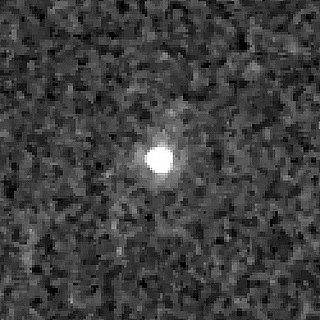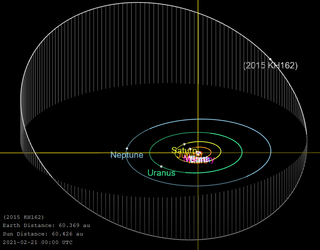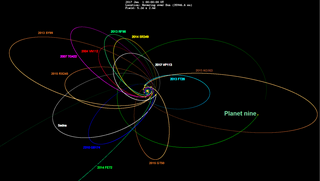Related Research Articles

(612911) 2004 XR190, nicknamed Buffy, is a trans-Neptunian object, classified as both a scattered disc object and a detached object, located in the outermost region of the Solar System. It was first observed on 11 December 2004, by astronomers with the Canada–France Ecliptic Plane Survey at the Mauna Kea Observatories, Hawaii, United States. It is the largest known highly inclined (> 45°) object. With a perihelion of 51 AU, it belongs to a small and poorly understood group of very distant objects with moderate eccentricities.
(119070) 2001 KP77, provisional designation:2001 KP77, is a resonant trans-Neptunian object in the Kuiper belt, a circumstellar disc located in the outermost region of the Solar System. It was discovered on 23 May 2001, by American astronomer Marc Buie at the Cerro Tololo Observatory in Chile. The object is locked in a 4:7 orbital resonance with Neptune. It has a red surface color and measures approximately 176 kilometers (110 miles) in diameter. As of 2021, it has not been named.

(42301) 2001 UR163, prov. designation: 2001 UR163, is a resonant trans-Neptunian object and possible dwarf planet located in the outermost region of the Solar System. The object measures approximately 352 kilometers (220 miles) in diameter with a high albedo and stays in an uncommon orbital resonance (4:9) with Neptune. It was discovered on 21 October 2001 by astronomers of the Deep Ecliptic Survey program at Kitt Peak National Observatory near Tucson, Arizona, United States. As of 2021, it has not been named.

2006 QH181, also written as 2006 QH181, is a trans-Neptunian object (TNO) in the scattered disc. Its orbit is currently too poorly determined (U=6) to know whether it is in a resonance with Neptune.
(35671) 1998 SN165, prov. designation: 1998 SN165, is a trans-Neptunian object from the Kuiper belt located in the outermost region of the Solar System. It was discovered on 23 September 1998, by American astronomer Arianna Gleason at the Kitt Peak National Observatory near Tucson, Arizona. The cold classical Kuiper belt object is a dwarf planet candidate, as it measures approximately 400 kilometers (250 miles) in diameter. It has a grey-blue color (BB) and a rotation period of 8.8 hours. As of 2021, it has not been named.

(612584) 2003 QX113 is a large trans-Neptunian object from the scattered disc located in the outermost region of the Solar System. It is one of the most distant objects from the Sun at 60.5 AU. It was discovered by astronomers with the Canada–France Ecliptic Plane Survey at Mauna Kea Observatories, Hawaii, when it was near aphelion on 31 August 2003. It was provisionally designated 2003 QX113.

(528381) 2008 ST291, provisional designation 2008 ST291, is a 1:6 resonant trans-Neptunian object located in the outermost region of the Solar System that takes almost a thousand years to complete an orbit around the Sun. It was discovered on 24 September 2008 by American astronomers Megan Schwamb, Michael Brown and David Rabinowitz at the Palomar Observatory in California, with no known earlier precovery images.
(589683) 2010 RF43, provisionally designated: 2010 RF43, is a large trans-Neptunian object orbiting in the scattered disc in the outermost regions of the Solar System. The object was discovered on 9 September 2010, by American astronomers David Rabinowitz, Megan Schwamb and Suzanne Tourtellotte at ESO's La Silla Observatory in northern Chile.
(78799) 2002 XW93, provisional designation 2002 XW93, is a trans-Neptunian object and centaur from the outer Solar System, approximately 500–600 kilometers (300–400 mi) in diameter. It was discovered on 10 December 2002, by astronomers at the Palomar Observatory in California.

2014 FC69 is a trans-Neptunian object of the scattered disc on an eccentric orbit in the outermost region of the Solar System. It was first observed on 25 March 2014, by American astronomers Scott Sheppard and Chad Trujillo at the Cerro Tololo Observatory in Chile. It is one of the most distant objects from the Sun, even further away than Sedna.

2015 KH162 is a large trans-Neptunian object orbiting in the scattered disc region of the outermost Solar System. First observed in 2015, this minor planet is one of the most distant objects from the Sun at 60.6 AU, or twice as far as Neptune.
2013 GP136 is a trans-Neptunian object from the scattered disc in the outermost reaches of the Solar System, approximately 212 kilometers in diameter. It was discovered on 8 February 2013, by the Outer Solar System Origins Survey at the Mauna Kea Observatories on the island of Hawaii, United States.

2014 UZ224 is a trans-Neptunian object and possible dwarf planet orbiting in the scattered disc of the outermost Solar System. As of 2021, it is approximately 89.7 AU (13.42 billion km) from the Sun, and will slowly decrease in distance until it reaches its perihelion of 38 AU in 2142. The discoverers have nicknamed it "DeeDee" for "Distant Dwarf".

2015 RX245 is an extreme trans-Neptunian object, detached, on a highly eccentric orbit in the outermost region of the Solar System. It measures approximately 250 kilometers (160 miles) in diameter and is "possibly" a dwarf planet. It was first observed on 8 September 2015, by astronomers with Outer Solar System Origins Survey using the 3.6-meter Canada–France–Hawaii Telescope at Mauna Kea Observatories, Hawaii, in the United States.
(574372) 2010 JO179, provisional designation: 2010 JO179, is a large, high-order resonant trans-Neptunian object in the outermost regions of the Solar System, approximately 700 kilometers (430 miles) in diameter. Long-term observations suggest that the object is in a meta-stable 5:21 resonance with Neptune. Other sources classify it as a scattered disc object. It is possibly large enough to be a dwarf planet.
(543354) 2014 AN55 (prov. designation:2014 AN55) is a trans-Neptunian object in the scattered disc, located in the outermost region of the Solar System, that measures approximately 600 kilometres (370 mi) in diameter. It was discovered on 25 January 2014, by astronomers with the Pan-STARRS survey at Haleakala Observatory on the island of Maui, Hawaii, in the United States.
2015 FJ345 is a trans-Neptunian object and detached object, located in the scattered disc, the outermost region of the Solar System. It was first observed on 17 March 2015, by a team led by American astronomer Scott Sheppard at the Mauna Kea Observatories, in Hawaii, United States. With its perihelion of almost 51 AU, it belongs to a small and poorly understood group of very distant objects with moderate eccentricities. The object is not a dwarf planet candidate as it only measures approximately 120 kilometers (75 miles) in diameter.
(523706) 2014 HF200, provisional designation 2014 HF200, is a trans-Neptunian object on an eccentric orbit from the scattered disc, located in the outermost region of the Solar System. It was discovered on 20 May 2012, by astronomers with the Pan-STARRS survey at Haleakala Observatory, Hawaii, United States. The dwarf planet candidate measures approximately 300 kilometers (190 miles) in diameter.

2014 SV349 is a large trans-Neptunian object from the scattered disc located in the outermost region of the Solar System. It is one of the most distant objects from the Sun at 60.5 AU. The object is a dwarf planet candidate and measures approximately 423 kilometers (260 miles) in diameter. It was discovered on 19 September 2014, by American astronomer Scott Sheppard at the Cerro Tololo Observatory, Chile, and was provisionally designated 2014 SV349.
2014 UE228 is a trans-Neptunian object from the outermost region of the Solar System. The object is in a rare 3:8 resonance with Neptune and measures approximately 93 kilometers (58 miles) in diameter. It was first observed on 22 October 2014, by astronomers with the Outer Solar System Origins Survey at the Mauna Kea Observatories, Hawaii, and was provisionally designated 2014 UE228. As of 2021, it has not been numbered.
References
- 1 2 3 4 "2015 FG415". Minor Planet Center. Retrieved 8 September 2021.
- ↑ "MPEC 2019-F96 : 2015 FG415 (K15Ff5G)". Minor Planet Electronic Circular . Minor Planet Center. 27 March 2019. Retrieved 8 September 2021.
- ↑ "List Of Centaurs and Scattered-Disk Objects". Minor Planet Center. Retrieved 8 September 2021.
- 1 2 3 4 5 6 7 "JPL Small-Body Database Browser: (2015 FG415)" (2019-02-03 last obs.). Jet Propulsion Laboratory . Retrieved 8 September 2021.
- 1 2 3 4 5 "List of Known Trans-Neptunian Objects". Johnston's Archive. 18 August 2021. Retrieved 8 September 2021.
- 1 2 "Orbit Fit and Astrometric record for 15FG415". Southwest Research Institute . Retrieved 8 September 2021. (The Deep Ecliptic Survey Object Classifications)
- 1 2 "Asteroid Size Estimator". CNEOS NASA/JPL. Retrieved 8 September 2021.
- ↑ "Asteroid 2015 FG415 – Proper Elements". AstDyS-2, Asteroids – Dynamic Site. Retrieved 8 September 2021.
- ↑ "Observational Query: objects more than 57.0 AU from the Sun". AstDyS-2, Asteroids – Dynamic Site, Department of Mathematics, University of Pisa, Italy. Retrieved 8 September 2021.
- ↑ Brown, Michael E. "How many dwarf planets are there in the outer solar system?". California Institute of Technology . Retrieved 8 September 2021.